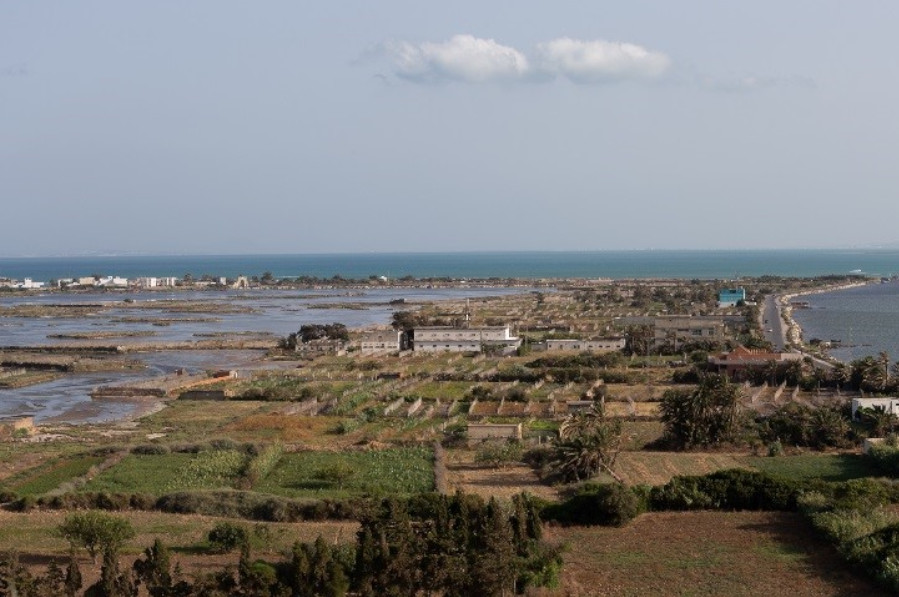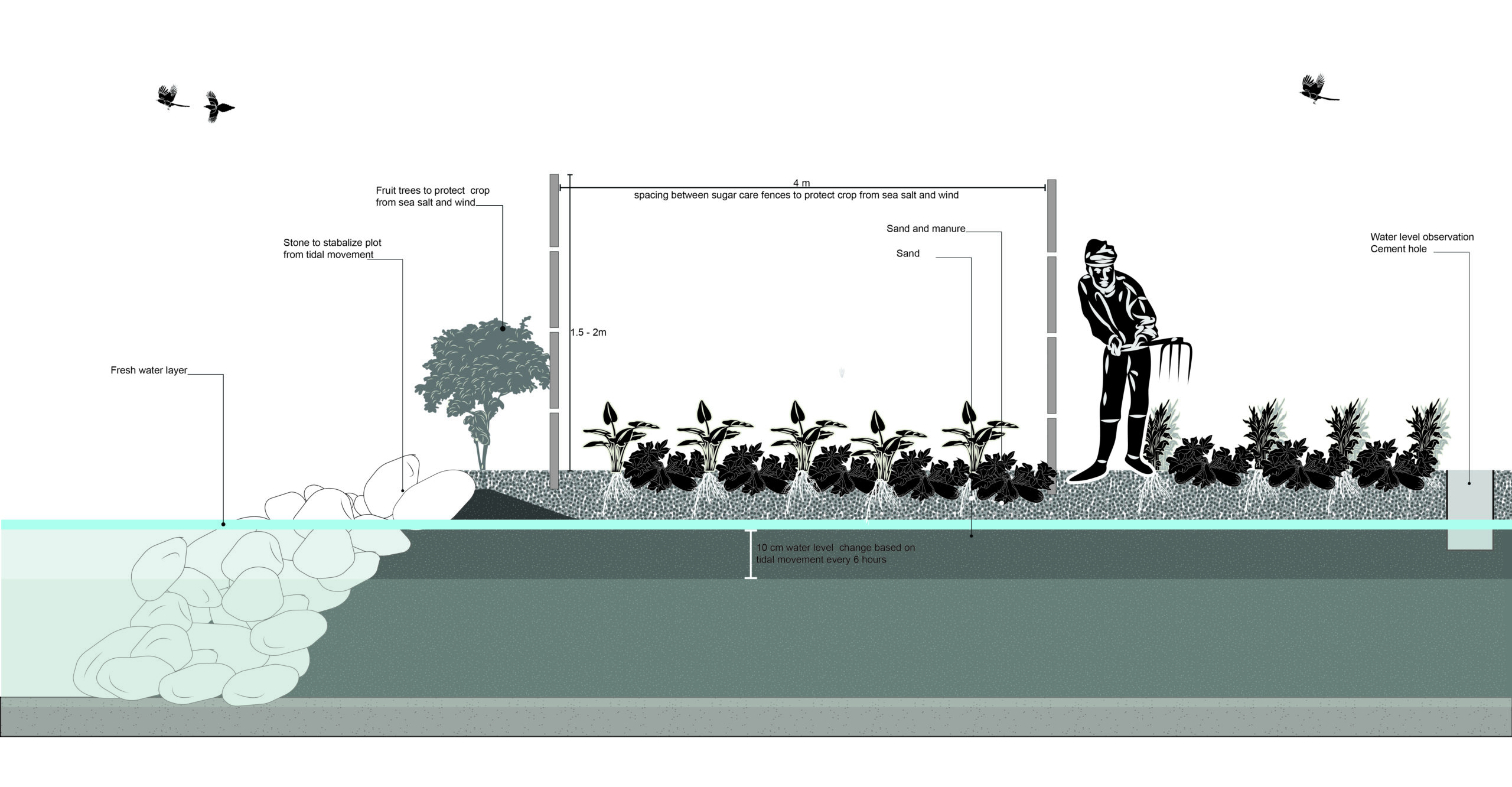Climate adaptation should not be approached with universal solutions. Designed primarily by and for affluent communities, the solutions considered best practice are often examples of “maladaptation,” causing more problems in the long term than the challenges they are trying to solve.
Photo: An aerial view of two kayalnilams separated by a water canal, which is similar to the dike and polder system in the Netherlands. Credit: Coconut Lagoon, a CGH Earth Experience
Table of Contents
In 2019, the Intergovernmental Panel on Climate Change (IPCC) released a special report on the ocean and cryosphere in a changing climate. The fourth chapter of this report focused on sea level rise and the implications for low-lying islands, coasts, outlining five different types of response: protection, accommodation, advance, retreat, and ecosystem-based adaptation [1]. Indigenous peoples and their responses to climate extremes remain largely excluded from such reports and the wider global discussion on adaptation, despite many local communities having already evolved effective adaptation methods over millennia in response to climate extremes. In what follows, we look at two examples of water-based Indigenous innovations, the Kuttanad Kayalnilam Farming System in India and the ramli lagoon farms in Tunisia, comparing them to the climate-adaptive scenarios presented by the IPCC.
Lo—TEK, a term coined by designer and author Julia Watson, is defined as resilient infrastructures developed by Indigenous people through traditional ecological knowledge (TEK). The movement to bring these innovations to the forefront of the design field counters the idea that Lo—TEK Indigenous innovation is low-tech, a term often incorrectly applied to Indigenous innovation that means unsophisticated, uncomplicated, and primitive. Instead, Lo—TEK aligns to sustainable values of low-energy, low-impact, and low-cost, while producing complex nature-based innovations that are inherently sustainable. Forming the foundation of Indigenous technologies, TEK is a field of study in anthropology defined as a cumulative body of knowledge, practice, and belief, handed down through generations by traditional songs, origin stories, and everyday life. By using TEK, humans have been able to harness the energy of ecosystems and adapt to environmental obstacles. Developed through direct contact with nature, TEK is engineered to sustain, rather than exploit resources. It fosters symbiosis between species, while making biodiversity the building block used to construct sustainable technologies.
Lo—TEK innovations come from a deep understanding of working with nature and are evolved from the philosophy of Radical Indigenism. Coined by a citizen of the Cherokee Nation, Professor Eva Marie Garoutte, Radical Indigenism argues for a rebuilding of knowledge and understanding of Indigenous philosophies from their roots. For design, this rebuilding can expand our understanding of nature-based technologies and generate new, sustainable, and resilient infrastructures informed by TEK. It is eminently possible to weave ancient knowledge on how to live symbiotically with nature into the ways in which we shape the cities of the future. We can rewild our urban landscapes and apply Lo—TEK ecological thinking to climate solutions for sanitation, storm surge, sea level rise, drought, deluge, wildfire, food supply, and water, that have worked for Indigenous peoples for thousands of years. Lo—TEK expands the definition of contemporary technology by rebuilding our understanding of climate resilient design using Indigenous knowledge and practices that are sustainable, adaptable, and borne out of necessity.
The Kuttanad Kayalnilam Farming System by the Malayalis in India
Kuttanad, a low-lying wetland at the mouth of the Vembanad Backwaters in India, is the only place in the country where paddy farming has been practised below sea level for more than two centuries. It uses the strategy of advancing, which is adopted in many coastal cities where land is expanded into water by reclamation or by the use of dikes. In this system, the artificially created landforms are called kayalnilams, where kayal means backwaters and nilam means ground, implying that they were lifted out of water. The kayalnilam system intelligently accommodates seasonal flooding and salinity intrusion, allowing the Malayalis to grow rice, coconut, and other fruit trees through the local technology and water management practices associated with the kayalnilams.
Figure 1

The system is composed of earthen dykes, canals, and ponds that rise and fall above the backwaters. (Figure 1). The constructed module forms a two-tier system, making it adaptable to seasonal precipitation. These raised earth structures, or bio-bunds, known as kuttiyum chirayum, are made of local materials including coconut poles, bamboo mats, sand, twigs, and sedges like cattail (Typha latifolia) and common three square (Schoenoplectus pungens), interspersed with high quality clay dug from a lake depth of 20-25m. The bunds separate the canals which hold water used for irrigation. The water enters the paddy fields through a flexible opening in the bund called a thoomba. However, to avoid excess water entering the paddy fields, dewatering technologies called pettiyum parayum (Figure 2) are placed at strategic junctures between the bunds and the canals. To block the seasonal entry of salt, temporary barriers called orumuttu, made of sand bags and twigs are built above the salt water level, allowing only fresh water to enter the paddy fields. The entire system is lined with an exterior bund which acts as a sea defence barrier against fluctuating tidal levels.
Figure 2

Beyond coastal resilience and agricultural optimisation, these bunds and canals also improve water quality and structure a complex habitat. The bunds are a favourable ground for freshwater prawns and other aquatic species, while the canals serve both as a fish nursery and hunting ground. Fish venturing upstream during high tide are trapped in the system by a detachable net fitted inside the pettiyum or the box. Stirring movements of the fish aerate the planting bed, improving the surface soil conditions both in terms of porosity and fertility. This accelerates the growth of paddy crops and provides oxygen and food for fish. This interdependent relationship between rice and fish is further enhanced by the recurring movement of salt and water in the system.
Figure 3

Rotating between agriculture and aquaculture, the people of Kuttanad live in harmony with the seasonal mixing of fresh and saline water (Figure 3). While water flows from rivers into the sea for most of the year, during the pre-monsoon when river flow drops below sea level, water flow reverses to travel inland from the sea, bringing salt – a curse for farmers. The increased salinity is unsuitable for paddy cultivation, so kayalnilams are deliberately flooded for the seasonal transition to aquaculture and duck rearing. The freshwater needed for paddy cultivation is restored with the onset of the monsoon. Paddy fields accommodate excess water during heavy rains while the soil is enriched with silt and duck droppings and farmers prepare the submerged ground. Post-monsoon, water levels recede and the paddy fields begin growing crops, which are harvested before the next saltwater intrusion from the sea.
Due to the resemblance with the Traditional Dutch landscape, Kuttanad is often referred to as the “Holland of the East” by the western world. But unlike the polder dike system constructed for flood prevention in the Netherlands, the kayalnilams engineered in local building materials allow a higher degree of flexibility for seasonal exchange of salt and water, while exerting less control over the natural processes. As a local technology, the kayalnilams are living, intertidal landscapes that adapt to the vulnerability of flooding and salt intrusion by supporting food production, securing livelihoods, and minimally disturbing the natural balance of the ecosystem. At the watershed scale, these landscapes act as a seasonal retention basin, harmonising the construction, maintenance, and operation of agricultural infrastructure with the water cycle. The circle of life in the kayalnilams, characterised by a multi-species ecosystem, is linked to this cycle of water and salt, intermingling with the cycle of agriculture and aquaculture. In the wake of global food insecurity and salt intrusion upon vital coastal agricultural lands, further aggravated by climate change, this traditional land-water technology can be a model for the future direction of intertidal agricultural landscapes.
Ramli Lagoon Farms of the Andalusians in Ghar El Melh, Tunisia
A strategy for sea level rise outlined by the IPCC is ‘surrender’ or ‘accommodate,’ which deals with sea level rises by letting in water. The IPCC’s definition of accommodation refers to the redesign of physical and political infrastructure to accommodate sea level rise and reduce vulnerability. The ramli lagoon farms in Ghar El Melh, Tunisia are an example of this, with unique agricultural practice on man-made islands that utilises fresh water accumulation on a salt water surface. The Tunisian coastline today is home to nearly two-thirds of the Tunisian population of twelve million people. However, these dry, coastal areas make cultivation a challenge. In response to the lack of cultivable coastal land, the poor-quality soil, and the scarcity of irrigation water came ingenious agricultural techniques like the two hundred and ninety ramli farms cultivated by the farmers, or fellahs.
Figures 4-6: Ghar El Melh lagoon, with ramli



On the shores of Ghar El Melh lagoon, adjacent to the Mediterranean Sea, is a thin strip of urban buildings that gradually opens into a vast lagoon with scattered vegetated islands. For over a thousand years, silt in the lagoon has led to the formation of sand barriers parallel to the coastline. A coastal barrier called a boughaz, separating the lagoon from the Mediterranean Sea, was introduced, allowing seawater to flow into the lagoon. Today, the lagoon is further shaped by the construction of the ramli using sand excavated from the shoreline. The word ramli, which means sand in Arabic, points to this transportation of sand from the shores to reclaim land along the shoreline of the lagoon.
Figure 7

The varying sizes of the ramli sand beds form the base modules of construction for growing an intensive polyculture of seasonal, shallow-rooted crops like potatoes, tomatoes, pepper, and fennel. The whole system was lined by reed trays, planting hedges, and fruit trees located peripherally with sugarcane or cane branch fencing added to protect them from the sea spray, slow the evaporation process, and stabilise the sand beds. (Figure 7). A major challenge these cultivated plots encountered was saline intrusion from the lagoon. In response, the fellahs developed an innovative year-round passive irrigation system that makes use of freshwater tidal fluctuations in the lagoon. Relying on tidal movements in the lagoon, and seawater being denser than freshwater due to its salt content, freshwater reaches the plant roots through capillary action. This layer of fresh water moves up and down twice a day, every six hours during high and low tides. As the freshwater saturates the sand twice daily, it nourishes the roots of the crop from the ground up. Any imbalance to the system will cause the crop to fail. The fellahs who manage the system are charged with balancing both the sea and soil levels which must remain equal by adding sand and manure (Figure 8).
Figure 8

Although the island farms were constructed to support agriculture in an aquatic environment, they have also played a critical role in shaping the morphology of the lagoon. The ramli offer a living example of humans and nature exchanging roles, alternating between being makers and takers of the landscape. By planning intelligent crop rotations, the ramli can be cultivated throughout the entire year. Due to these ingenious natural irrigation methods that work symbiotically with the water cycles and the water regimes of the plants, these techniques are vital to areas facing water scarcity due to the lack of availability of freshwater and where saltwater poses a constant threat.
Lo—TEK for Climate Resilience
Climate change and sea level rise are unprecedented adversaries that are adaptive, responsive, and capable of complex interactions along coastlines. Variations in local conditions, communities, and ecosystems coupled with global weather patterns warrant unique responses that amplify strengths and counter weaknesses. In the end, avoiding catastrophe will largely depend on individual responses by communities and governments, rather than universal engineered approaches. While the Global North biases the universal climate solutions of high-tech, hard infrastructures, another approach found predominantly in the Global South remains unacknowledged. The existing and undervalued nature-based technologies that have evolved from thousands of years of place-based knowledge are continually erased following the ‘north knows best’ narrative. These local technologies offer a more socially and environmentally equitable alternative for nations fortunate enough to have these highly sophisticated technologies that work in complex symbiosis with their natural systems still in existence.
We cannot go backwards, fixing all of the hard infrastructures, creating more extractive activities, and displacing more communities. These activities have exacerbated climate change, social injustice, and a great loss of biodiversity. Further, the thinking that glorifies high-tech infrastructures has undervalued traditional solutions and has eventually put them in a position of risk. Instead, we can go forward by funding, rethinking, rebuilding, and scaling climate solutions that support the resilience of both communities and cities, while addressing the inequalities and distance from nature that our current systems and climate solutions support.
Endnotes
- The 2022 IPCC publication on Impacts, Adaptation and Vulnerability of Climate Change has recently been published, however the categories outlined in the 2019 report remain the basis of our work.
This article is based around ‘Design by Radical Indigenism: Equitable Underwater & Intertidal Technologies of the Global South’, published in Landscape Metropolis 8:3 in 2021, by the same authors.
This in turn follows Julia Watson’s 2019 book published by Taschen Lo-TEK: Design by Radical Indigenism, available to buy here.
Julia Watson is a designer, activist, academic and author, with expertise in Indigenous nature-based technologies. Her unconventional practice led to research, writing, and design projects inspired by pilgrimages to Indigenous sites, while her formal education has led to teaching positions at Harvard, Columbia, RISD, and Rensselaer universities.




